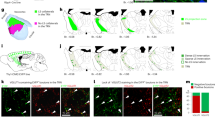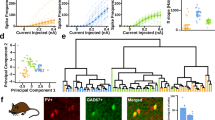Abstract
The thalamus provides fundamental input to the neocortex. This input activates inhibitory interneurons more strongly than excitatory neurons, triggering powerful feedforward inhibition. We studied the mechanisms of this selective neuronal activation using a mouse somatosensory thalamocortical preparation. Notably, the greater responsiveness of inhibitory interneurons was not caused by their distinctive intrinsic properties but was instead produced by synaptic mechanisms. Axons from the thalamus made stronger and more frequent excitatory connections onto inhibitory interneurons than onto excitatory cells. Furthermore, circuit dynamics allowed feedforward inhibition to suppress responses in excitatory cells more effectively than in interneurons. Thalamocortical excitatory currents rose quickly in interneurons, allowing them to fire action potentials before significant feedforward inhibition emerged. In contrast, thalamocortical excitatory currents rose slowly in excitatory cells, overlapping with feedforward inhibitory currents that suppress action potentials. These results demonstrate the importance of selective synaptic targeting and precise timing in the initial stages of neocortical processing.
This is a preview of subscription content, access via your institution
Access options
Subscribe to this journal
Receive 12 print issues and online access
$209.00 per year
only $17.42 per issue
Buy this article
- Purchase on Springer Link
- Instant access to full article PDF
Prices may be subject to local taxes which are calculated during checkout




Similar content being viewed by others
References
Mountcastle, V.M. Perceptual Neuroscience (Harvard University Press, Cambridge, Massachusetts, USA, 1998).
Gibson, J.R., Beierlein, M. & Connors, B.W. Two networks of electrically coupled inhibitory neurons in neocortex. Nature 402, 75–79 (1999).
Porter, J.T., Johnson, C.K. & Agmon, A. Diverse types of interneurons generate thalamus-evoked feedforward inhibition in the mouse barrel cortex. J. Neurosci. 21, 2699–2710 (2001).
Bruno, R.M. & Simons, D.J. Feedforward mechanisms of excitatory and inhibitory cortical receptive fields. J. Neurosci. 22, 10966–10975 (2002).
Swadlow, H.A. Thalamocortical control of feedforward inhibition in awake somatosensory 'barrel' cortex. Phil. Trans. R. Soc. Lond. B 357, 1717–1727 (2002).
Agmon, A. & Connors, B.W. Correlation between intrinsic firing patterns and thalamocortical synaptic responses of neurons in mouse barrel cortex. J. Neurosci. 12, 319–329 (1992).
Gil, Z. & Amitai, Y. Properties of convergent thalamocortical and intracortical synaptic potentials in single neurons of neocortex. J. Neurosci. 16, 6567–6578 (1996).
Beierlein, M., Gibson, J.R. & Connors, B.W. Two dynamically distinct inhibitory networks in layer 4 of the neocortex. J. Neurophysiol. 90, 2987–3000 (2003).
Gabernet, L., Jadhav, S.P., Feldman, D.E., Carandini, M. & Scanziani, M. Somatosensory integration controlled by dynamic thalamocortical feedforward inhibition. Neuron 48, 315–327 (2005).
Inoue, T. & Imoto, K. Feedforward inhibitory connections from multiple thalamic cells to multiple regular-spiking cells in layer 4 of the somatosensory cortex. J. Neurophysiol. 96, 1746–1754 (2006).
Sun, Q.Q., Huguenard, J.R. & Prince, D.A. Barrel cortex microcircuits: thalamocortical feedforward inhibition in spiny stellate cells is mediated by a small number of fast-spiking interneurons. J. Neurosci. 26, 1219–1230 (2006).
Miller, K.D., Pinto, D.J. & Simons, D.J. Processing in layer 4 of the neocortical circuit: new insights from visual and somatosensory cortex. Curr. Opin. Neurobiol. 11, 488–497 (2001).
Douglas, R.J. & Martin, K.A. Neuronal circuits of the neocortex. Annu. Rev. Neurosci. 27, 419–451 (2004).
Alonso, J.M. & Swadlow, H.A. Thalamocortical specificity and the synthesis of sensory cortical receptive fields. J. Neurophysiol. 94, 26–32 (2005).
Agmon, A. & Connors, B.W. Thalamocortical responses of mouse somatosensory (barrel) cortex in vitro. Neuroscience 41, 365–379 (1991).
Lawrence, J.J. & McBain, C.J. Interneuron diversity series: containing the detonation-feedforward inhibition in the CA3 hippocampus. Trends Neurosci. 26, 631–640 (2003).
Jonas, P., Bischofberger, J., Fricker, D. & Miles, R. Interneuron diversity series: fast in, fast out—temporal and spatial signal processing in hippocampal interneurons. Trends Neurosci. 27, 30–40 (2004).
Wehr, M. & Zador, A.M. Balanced inhibition underlies tuning and sharpens spike timing in auditory cortex. Nature 426, 442–446 (2003).
McNaughton, B.L., Barnes, C.A. & Andersen, P. Synaptic efficacy and EPSP summation in granule cells of rat fascia dentata studied in vitro. J. Neurophysiol. 46, 952–966 (1981).
Staiger, J.F., Zilles, K. & Freund, T.F. Distribution of GABAergic elements postsynaptic to ventroposteromedial thalamic projections in layer IV of rat barrel cortex. Eur. J. Neurosci. 8, 2273–2285 (1996).
Martina, M., Royer, S. & Pare, D. Cell type–specific GABA responses and chloride homeostasis in the cortex and amygdala. J. Neurophysiol. 86, 2887–2895 (2001).
Owens, D.F. & Kriegstein, A.R. Is there more to GABA than synaptic inhibition? Nat. Rev. Neurosci. 3, 715–727 (2002).
Gulledge, A.T. & Stuart, G.J. Excitatory actions of GABA in the cortex. Neuron 37, 299–309 (2003).
Jin, X., Huguenard, J.R. & Prince, D.A. Impaired Cl− extrusion in layer V pyramidal neurons of chronically injured epileptogenic neocortex. J. Neurophysiol. 93, 2117–2126 (2005).
Szabadics, J. et al. Excitatory effect of GABAergic axo-axonic cells in cortical microcircuits. Science 311, 233–235 (2006).
Steriade, M., Timofeev, I. & Grenier, F. Natural waking and sleep states: a view from inside neocortical neurons. J. Neurophysiol. 85, 1969–1985 (2001).
Bruno, R.M. & Sakmann, B. Cortex is driven by weak but synchronously active thalamocortical synapses. Science 312, 1622–1627 (2006).
Higley, M.J. & Contreras, D. Balanced excitation and inhibition determine spike timing during frequency adaptation. J. Neurosci. 26, 448–457 (2006).
Galarreta, M. & Hestrin, S. Spike transmission and synchrony detection in networks of GABAergic interneurons. Science 292, 2295–2299 (2001).
Geiger, J.R. et al. Relative abundance of subunit mRNAs determines gating and Ca2+ permeability of AMPA receptors in principal neurons and interneurons in rat CNS. Neuron 15, 193–204 (1995).
Lambolez, B., Ropert, N., Perrais, D., Rossier, J. & Hestrin, S. Correlation between kinetics and RNA splicing of α-amino-3-hydroxy-5-methylisoxazole-4-propionic acid receptors in neocortical neurons. Proc. Natl. Acad. Sci. USA 93, 1797–1802 (1996).
Zhou, F.M. & Hablitz, J.J. AMPA receptor–mediated EPSCs in rat neocortical layer II/III interneurons have rapid kinetics. Brain Res. 780, 166–169 (1998).
Geiger, J.R., Lubke, J., Roth, A., Frotscher, M. & Jonas, P. Submillisecond AMPA receptor–mediated signaling at a principal neuron-interneuron synapse. Neuron 18, 1009–1023 (1997).
Walker, H.C., Lawrence, J.J. & McBain, C.J. Activation of kinetically distinct synaptic conductances on inhibitory interneurons by electrotonically overlapping afferents. Neuron 35, 161–171 (2002).
Benshalom, G. & White, E.L. Quantification of thalamocortical synapses with spiny stellate neurons in layer IV of mouse somatosensory cortex. J. Comp. Neurol. 253, 303–314 (1986).
Keller, A. & White, E.L. Synaptic organization of GABAergic neurons in the mouse SmI cortex. J. Comp. Neurol. 262, 1–12 (1987).
Ahmed, B., Anderson, J.C., Douglas, R.J., Martin, K.A. & Nelson, J.C. Polyneuronal innervation of spiny stellate neurons in cat visual cortex. J. Comp. Neurol. 341, 39–49 (1994).
Ahmed, B., Anderson, J.C., Martin, K.A. & Nelson, J.C. Map of the synapses onto layer 4 basket cells of the primary visual cortex of the cat. J. Comp. Neurol. 380, 230–242 (1997).
Wilent, W.B. & Contreras, D. Dynamics of excitation and inhibition underlying stimulus selectivity in rat somatosensory cortex. Nat. Neurosci. 8, 1364–1370 (2005).
Moore, C.I., Nelson, S.B. & Sur, M. Dynamics of neuronal processing in rat somatosensory cortex. Trends Neurosci. 22, 513–520 (1999).
Chattopadhyaya, B. et al. Experience and activity-dependent maturation of perisomatic GABAergic innervation in primary visual cortex during a postnatal critical period. J. Neurosci. 24, 9598–9611 (2004).
Acknowledgements
We thank our colleagues A. Agmon, O. Ahmed, C. Aizenman, J.-M. Edeline, E. Fanselow, A. Gray, S.-C. Lee, M. Long, R. Metherate, K. Pratt, K. Richardson, B. Rudy and H. Swadlow for their helpful comments about this work; S. Patrick for technical assistance; and Z. Huang for providing G42 mice. Our research was supported by grants from the US National Institutes of Health, the US National Science Foundation and the Brown University Brain Science Program.
Author information
Authors and Affiliations
Corresponding author
Ethics declarations
Competing interests
The authors declare no competing financial interests.
Supplementary information
Supplementary Fig. 1
GFP expression in FS cells of the G42 mouse line. (PDF 856 kb)
Supplementary Fig. 2
Mean intrinsic properties, reversal potentials and synaptic conductances recorded during the experiments and applied in the models. (PDF 127 kb)
Supplementary Fig. 3
The influence of Ge kinetics on functional inhibition depends on inhibitory driving force. (PDF 110 kb)
Supplementary Fig. 4
Effects of input resistance (Rin) on time-course of PSPs. (PDF 127 kb)
Rights and permissions
About this article
Cite this article
Cruikshank, S., Lewis, T. & Connors, B. Synaptic basis for intense thalamocortical activation of feedforward inhibitory cells in neocortex. Nat Neurosci 10, 462–468 (2007). https://doi.org/10.1038/nn1861
Received:
Accepted:
Published:
Issue Date:
DOI: https://doi.org/10.1038/nn1861
This article is cited by
-
Local origin of excitatory–inhibitory tuning equivalence in a cortical network
Nature Neuroscience (2024)
-
The impact of the human thalamus on brain-wide information processing
Nature Reviews Neuroscience (2023)
-
The cerebellum contributes to generalized seizures by altering activity in the ventral posteromedial nucleus
Communications Biology (2023)
-
Inhibition allocates spikes during hippocampal ripples
Nature Communications (2022)
-
Distinct organization of two cortico-cortical feedback pathways
Nature Communications (2022)



